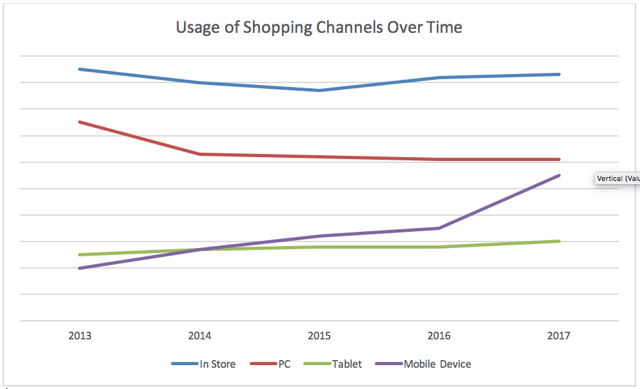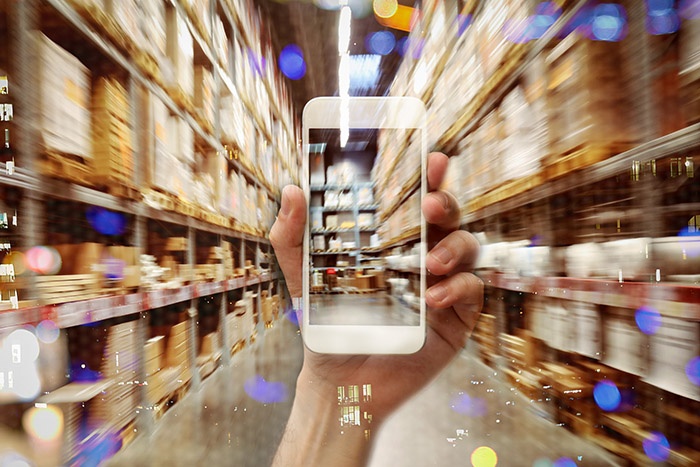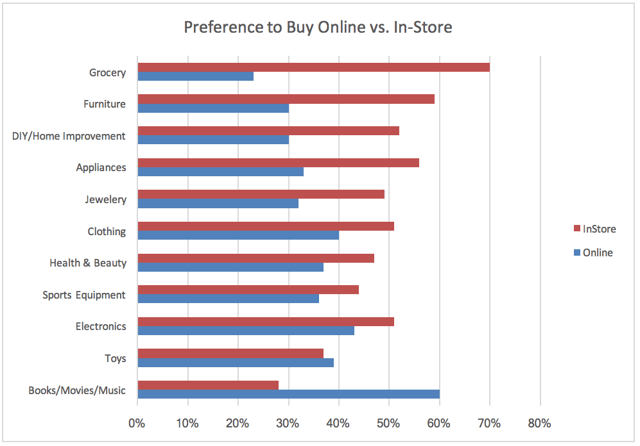For any of us that have worked extensively over the years on packaging design, planograms, POP messaging and other in-store tactics, the dramatic shift toward online sales is a crystal-clear call for omni-channel thinking. It’s evident that we must present products in the best light for sales conversions “everywhere” while certainly not forgetting a continued strong focus on brick and mortar stores. To make the most of this new shopping landscape, there are some emerging best practices worth noting.
As 2018 gets underway, the US finds itself entering the third year of a “retail apocalypse”. Coined in 2016, the term Retail Apocalypse of course refers to the rapidly changing face of retail business today. The struggles of giants such Sears and JC Penney are well-documented. But there is hardly a retailer that hasn’t felt the effects of this growing meltdown.
Even Wal-Mart Stores, Inc. is changing its name to simply Walmart, dropping the word “stores”, even though there are nearly 6,500 physical Wal-Mart locations worldwide. In 2017 alone, nearly 7,000 different locations of various major retailers have closed1 and of the 1,200 remaining US malls, 25% could close by 20222. While there are many reasons for these closures, the continued shift towards online sales is the primary factor.
While the current trend is a huge disruption for traditional retailers, it does not necessarily mean doom and gloom for manufacturers. People are not buying less stuff. They are simply changing their buying habits and, in fact, are enjoying “more” of everything. More brand choices, more channels to buy things, more information, more advertising and more social influence. So how does a consumer products brand stay relevant in this changing landscape.
Making The Shift To Omni-Channel Marketing
In an omni-channel approach, the marketing focus is upon serving customers in a way that creates an integrated and consistent experience no matter how or where they may have contact with your brand. In that quest to maximize impact with every touch, we certainly do not wish to ignore traditional retail outlets and the important role they still play. A 2016 survey of more than 5000 consumers conducted by analytics firm comScore and UPSclaims that while some shoppers are doing a majority of their purchasing online (51%), most consumer products categories are still primarily purchased in stores.
A 2017 Total Retail Survey provided by PwC supports that premise, noting that 60% of shoppers for books, music, movies and video games prefer to shop online, but only 30% of shoppers for DIY and home improvement products prefer to shop online. However, the same study reports that in almost every consumer products category the vast majority of shoppers prefer to research their purchases online, whether or not they complete the purchase on the internet. Conversely, many consumers research products in-store, where they can touch and feel the product, before buying online.
Source: PwC

Source: PwC
Strengthen Your In-Store Presentation System
It is clear, then, that a solid in-store merchandising strategy is at least as relevant today as it has been in years past. Traditional rules still apply:
- Well-designed packaging that quickly and clearly explains the benefits of your product.
- Signage that ties into your brand story and helps consumers make a selection.
Retailers still rely on manufacturers to create organized planograms, compelling displays and unique In-store promotions. - If applicable: Creative product demonstrations at the point of purchase.
Interactive technologies such as in-store video players or QR code links to online videos can go a long way toward answering shopper questions and closing sales. To recognize and take advantage of the convergence of online technologies with traditional shopping venues, explore every avenue and take your in-store presence and merchandising to the next level. - Investing in effective product knowledge training for store associates.
Shoppers typically value a small number of core things that keep them coming back to physical locations. 78% of shoppers go to stores because they value having sales associates with a deep knowledge and understanding of the product range.4 If you can’t get to every location and do personal training, create online training modules or apps that can be loaded onto associates’ phones that teach them about the category, not just your brand. 68% of consumers also want the ability to quickly check stock at other stores, or online, quickly.4 Making sure stores are well stocked is key. - Location-based, personalized promotions
In-store merchandising today goes even further than that. 59% of shoppers want to see real-time, personalized offers designed especially for them.4 Knowing the importance of smart phones and the role they play during in-store shopping research, you can combine your online advertising with location-based targeting to deliver a special offer immediately to a single person. Almost 60% of shoppers also want the ability to see and/or order an extended selection of products on screen right in the store.4 So, developing easy special-order programs, or partnering with retailers on their apps and websites is needed to help marry physical-location shopping with the cyber experience.
Audit Your Online Content
When merchandising your products online, some of the same things are needed, but there are also unique aspects of selling your products on the internet that need to be addressed. First, the basics: Visual merchandising is just as important online as it is in stores. Strengthen your online presention with:
- Good photography (In-use shots, product views at several angles, package views).
- Usage and installation videos
- Sales literature PDFs
- Instruction manual and design guide PDFs
- Compelling copy including short and long-form product descriptions
- All important product specifications
If an online retailer uses their own photography, make sure it shows your products in a good light, and work with them if it doesn’t.
Cultivate Great Reviews by Engaging With Your Customers
Keep in mind that one of the reasons internet shopping is so popular is because of the unique features of web-based commerce. Many of these identifying characteristics are not directly controlled by your marketing department. For example, user reviews have become one of the biggest merchandising tools going. Amazon knows this and is planning its own brands around the concept. Bloomberg recently reported that Amazon is working with designer Jackie Wilson to provide Amazon-branded clothing that focuses almost solely on customer satisfaction. Wilson reported, “They want 5-star reviews. They are not concerned at all about how many units they sell, and they’re not focused on margins”.5 While most brands can’t afford to ignore margins, the article illustrates the point that when people talk about your brand in the form of user reviews online, other people listen and sales can follow on the merits of these reviews.
Incorporating this basic philosophy of social, and sometimes viral, customer satisfaction reporting into your online presence and merchandising becomes key. Encourage customer reviews on your own website, highlighting the good ones, while also honestly addressing the bad ones. Encourage your end-consumers to write about their experiences with your brand. Do this by following up on product registrations, website inquiries, customer support phone calls, etc. with invitations for the customer to write a review. Perhaps providing a special offer in exchange for leaving feedback at the point-of-purchase will encourage comments.
Once feedback starts coming in for your products, whether it be through user reviews or social media postings, it is important to engage these important potential ambassadors. If the reviews are not all positive, do not ignore negative comments. Own up to your shortcomings and use it as an opportunity to show that your brand listens and cares what customers think. Making an ambassador out of a previously dissatisfied customer is the power of the new world of merchandising.
Online merchandising may not exactly be a revolution, but it certainly provides the perfect platform for enhancing what you are already doing. By giving your brand more opportunities to sell themselves, while also inviting customers to sell for you, it can help you navigate this “apocalypse” and emerge even stronger than ever.
If you want to learn more about how your brand can grow with improved merchandising, both in-store and online, call Heinzeroth Marketing Group today for a free consultation. Or, check out case studies and eBooks online at heinzeroth.com. Our library of content covers topics ranging from successful merchandising strategies to marketing to millennials.
Download our Free PLR Meeting Checklist
Do you have a product line review (PLR) coming up with one or more of your retailers? Download this free checklist to improve your readiness for a successful meeting.



